The annual Kelowna Christmas Bird Count had a few surprises for counters this year, say organizers, but overall showed it to be an average year in terms of numbers of species identified here.
Chris Charlesworth, who has organized the count for more than 30 years, said 98 species of birds were identified by volunteer counters last month, smack dab in the middle of the normal 95 to 100 species typically identified here.
He said while a cold snap the week before the Dec. 17 count may have had an impact on the number of birds counted, local birding enthusiasts were surprised to see uncommon visitors who had flown in to this area and decided to stay.
He said seven snow geese were spotted, birds that would normally head to the Coast at this time of year.
“Some times (snow geese) get tucked in with a flock of Canada Geese, land here and decide to stay,” said Charlesworth.
He said this was also a good year for the number of swans spotted here but overall, waterfowl numbers were down, likely because of the cold weather, and the freezing over of smaller water-bodies.
One strange site that greeted observers was that of a turkey vulture seen in the Mission area, something Charlesworth described as “quite an exception.”
A lot of raptors and hawks were also spotted in this year’s count, including 116 red tail hawks.
A number of Eurasian collared doves were also spotted, a bird that up to 10 years ago was not seen here.
Charlesworth said they were originally was found in the southern U.S., typically Florida, where they had come over from Europe and Asia in the 1960s. But over last decade, they have gradually been making their way north. This year, 207 Eurasian collared doves were spotted here.
The Kelowna bird count is one of many conducted at this time of year across North America.
Charlesworth said the local count provides a good guide to what it happening to the bird population here when compared to previous years’ numbers.
He said overall, while bird populations in other parts of the country are dropping, here the bird population appears to be doing quite well.
But, he warned, continued development into areas that were once home to woodland birds, is having an impact on their numbers.
“Luckily, here in the Okanagan, we have a lot of birds,” he said.
Charlesworth said anyone interested in the bird count can go to the website birdscanada.org to get more information about the local count and counts conducted across the country.
